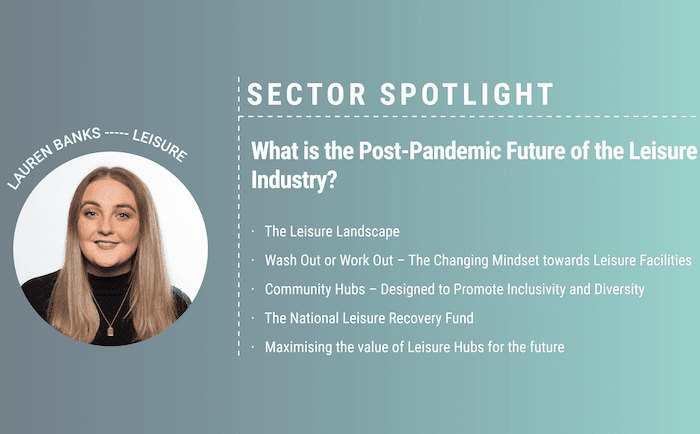Lockdowns and restrictions throughout the Covid-19 pandemic brought the UK leisure and fitness sector to a relative standstill. Leisure centres and community sports centres are vital resources to local communities, providing opportunities to improve fitness, health, and wellbeing. According to Sport England’s ‘Active Lives Adult Survey’, many found it challenging to maintain an active lifestyle because of the disruption, with a 7.4% rise in inactivity after the first lockdown. A staggering 3.4m more people inactive across the country. With Government reports finding that physical inactivity is estimated to cost £7.4 billion per year and is associated with 1 in 6 deaths in the UK, it is clear that the leisure industry has a pivotal role to play in raising the nation’s fitness and supporting the levelling up agenda for our future economic recovery. In this article Lauren Banks, Key Account Manager and Leisure Sector Lead, explores what the leisure industry may look like in the future.
The Leisure Landscape
The 2019 ‘State of the UK Fitness Industry Report’ evidenced the UK leisure industry was thriving pre-pandemic, with increases of 2.9% in fitness facilities over a 12-month period to the end of March 2019 and increases of 4.7% in the number of members (with 1 in 7 people owning gym membership) and 4.2% in market value. Local authorities were working hard with contractors to revitalise tired amenities and provide communities with facilities to improve their fitness. Two years on, there is an unprecedented demand for leisure facilities. More leisure providers, often local authorities in association with the NHS and Sports England, are thinking about what provision their communities require as the mindset towards health, fitness, and socialisation in the post- Covid world has evolved.
Wash Out or Work Out – The Changing Mindset towards Leisure Facilities
When the pandemic hit forcing temporary closures of leisure and sports facilities, the stress and boredom caused by constraints on our freedoms created an opportunity for some to engage in keep fit activities, using home gyms or getting outside and walking more. Individuals who had never previously been active were discovering the benefits of exercise, for both their physical and mental wellbeing. Digital health and fitness tools gained in popularity. This change in mindset towards fitness could not be ignored. Providers have been forced to consider the adequacy of their provision and think about how technology, design and innovation must be considered to attract more users.
Gyms have a long-standing reputation for muscle men, Lycra, and work out enthusiasts. Providers had previously struggled to attract a broader range of user type to encourage more people from the community to get active. Providers had to think about how leisure facilities could adapt to be more inclusive, to harness non-members with a newfound motivation in being active, and to re-engage with members to return to their exercise schedules.
Community Hubs – Designed to Promote Inclusivity and Diversity
Making leisure facilities fit for purpose and accessible for all is a key consideration for promoting these facilities as modern community hubs. Understanding what people want and incorporating that into the design of the building and the types of activities on offer will have a far-reaching appeal to a more diverse range of users. With 64% of people concerned about exercising in an enclosed environment with other people according to Sport England data, the space available and the overall design of the environment needs to change to help people feel safe.
The pandemic has accelerated the thought process within the leisure industry around overcoming barriers that stop users from engaging with leisure services. Everything from the design of the building to team orientated activities, bootcamp style workouts, zip wires, and soft play centres to encourage more users and create community hubs. Safety aspects such as space, hygiene, and ventilation must all be considerations. Natural ventilation systems allow for more fresh air circulation and the use of modern heat recovery systems to remove stale air not only reduces energy consumption, reducing operating costs and reducing the impact on the environment, but creates a healthier and safer space for people to exercise.
The location of leisure facilities is significant to the role it plays within the community. With the direction of travel being that leisure is seen as part of a social community hub, then positioning them close to other important public amenities such as libraries or parks will support integration and attract different users. Councils are leveraging the trend for ‘staycations’ and looking to develop leisure facilities in popular UK holiday locations.
The National Leisure Recovery Fund
Sport England are the administrators of the Government’s £100m National Leisure Recovery Fund. An initiative to ‘build back better’ and support 266 local authorities across England to reopen and restore public leisure centres and gyms to get the nation fitter. This has resulted in many leisure projects having an aligned agenda with the Sports England 2022/25 Plan, which aims to transform lives and communities through sport and physical activity.
Total Government contribution to local government finance equates to over £6 billion for the course of the pandemic, helping councils to deliver critical local services, including leisure facilities. Grassroots sports and the physical activity sector also received £270m in emergency funding delivered by Sport England, with the Government contributing £25m towards the growth of grassroots football, supporting the build of 700 new pitches across the UK. Funding for leisure projects is currently a collaboration with Health, Housing and Transport sectors.
Maximising the value of Leisure Hubs for the future
Sport England works closely with NHS Trusts to ensure sustainable long-term plans for leisure centres, ensuring projects are aligned with community needs to maximise the value of these modern community centric leisure hubs. As local authorities look for more cost-effective and efficient ways to procure their public sector projects, they are maximising the benefits of procuring through a framework. At Procure Partnerships we specialise in supporting public sector bodies with procurement that delivers on value for money and measurable social value. Our dedicated Leisure sector team has the knowledge and expertise to help guide and support Leisure projects through a successful procurement and delivery process.
Although the pandemic disrupted leisure activities, it has highlighted the importance of our health, fitness, and wellbeing more than ever. For the Government it has focussed attention on the need to invest in facilities to avoid a health crisis from inactivity and obesity, for local authorities and leisure providers it has identified a need to change and innovate facilities to be more accessible and inclusive for different users, and for individuals it has placed a spotlight on the value of our physical and mental health. The leisure and fitness industry plays a critical role in our communities and has an exciting future of growth ahead.



